Table of Contents
Guide
LINEARALGEBRALICENSE, DISCLAIMER OF LIABILITY, AND LIMITED WARRANTY By purchasing or using this book (the Work), you agree that this license grants permission to use the contents contained herein, but does not give you the right of ownership to any of the textual content in the book or ownership to any of the information or products contained in it.
This license does not permit uploading of the Work onto the Internet or on a network (of any kind) without the written consent ofthe Publisher. Duplication or dissemination of any text, code, simulations, images, etc. contained herein is limited to and subject to licensing terms for the respective products, and permission must be obtained from the Publisher or the owner of the content, etc., in order to reproduce or network any portion of the textual material (in any media) that is contained in the Work. MERCURY LEARNING AND INFORMATION (MLI or the Publisher) and anyone involved in the creation, writing, or production of the companion disc, accompanying algorithms, code, or computer programs (the software), and any accompanying Web site or software of the Work, cannot and do not warrant the performance or results that might be obtained by using the contents of the Work. The author, developers, and the Publisher have used their best efforts to insure the accuracy and functionality of the textual material and/or programs contained in this package; we, however, make no warranty of any kind, express or implied, regarding the performance of these contents or programs. The Work is sold as is without warranty (except for defective materials used in manufacturing the book or due to faulty workmanship).
The author, developers, and the publisher of any accompanying content, and anyone involved in the composition, production, and manufacturing of this work will not be liable for damages of any kind arising out of the use of (or the inability to use) the algorithms, source code, computer programs, or textual material contained in this publication. This includes, but is not limited to, loss of revenue or profit, or other incidental, physical, or consequential damages arising out of the use of this Work. The sole remedy in the event of a claim of any kind is expressly limited to replacement of the book, and only at the discretion of the Publisher. The use of implied warranty and certain exclusions vary from state to state, and might not apply to the purchaser of this product. LINEAR
ALGEBRALi-Yong Shen, PhD(University of the Chinese Academy of Sciences)Haohao Wang, PhD(Southeast Missouri State University)Jerzy Wojdylo, PhD(Southeast Missouri State University) Dulles, Virginia
Dulles, Virginia
Boston, Massachusetts
New Delhi Copyright 2019 by MERCURY LEARNING AND INFORMATION LLC. All rights reserved.
Original Title and Copyright: Linear Algebra. Copyright 2018 by. Overseas Press India Private Limited. All rights reserved. This publication, portions of it, or any accompanying software may not be reproduced in any way, stored in a retrieval system of any type, or transmitted by any means, media, electronic display or mechanical display, including, but not limited to, photocopy, recording, Internet postings, or scanning, without prior permission in writing from the publisher. Publisher: David Pallai MERCURY LEARNING AND INFORMATION 22841 Quicksilver Drive Dulles, VA 20166 www.merclearning.com (800) 232-0223 Li-Yong Shen, H. Wang, J. Linear Algebra. ISBN: 978-1-683923-76-3 The publisher recognizes and respects all marks used by companies, manufacturers, and developers as a means to distinguish their products. Linear Algebra. ISBN: 978-1-683923-76-3 The publisher recognizes and respects all marks used by companies, manufacturers, and developers as a means to distinguish their products.
All brand names and product names mentioned in this book are trademarks or service marks of their respective companies. Any omission or misuse (of any kind) of service marks or trademarks, etc. is not an attempt to infringe on the property of others. Library of Congress Control Number: 2018962730 181920321 This book is printed on acid-free paper in the USA. Our titles are available for adoption, license, or bulk purchase by institutions, corporations, etc. at 800-232-0223(toll free). at 800-232-0223(toll free).
All of our titles are available in digital format at authorcloudware.com and other digital vendors. The sole obligation of MERCURY LEARNING AND INFORMATION to the purchaser is to replace the book, based on defective materials or faulty workmanship, but not based on the operation or functionality of the product. CONTENTSPREFACE Linear algebra is one of the most widely used mathematical theories and has applications in virtually every area of mathematics, including multivariate calculus, differential equations, and probability theory. The purpose of this book is to bridge the gap between the abstract theoretical aspects and the computational applications of linear algebra. The aim of this book is two-fold: to introduce the fundamental concepts of linear algebra and to apply the theorems in computation-oriented applications. There are many good introductory texts on linear algebra, and the intention of this book is to be a supplement to those texts, or to serve as a text for senior undergraduate students or first year graduate students, whose interests are computational mathematics, science, engineering, and computer science.
The presentation of the material combines definitions and proofs with an emphasis on computational applications. We provide examples that illustrate the use of software packages such as Mathematica, Maple, and Sage. This book has evolved from our experience over several years of teaching linear algebra to mixed audiences of upper division mathematics majors, beginning graduate students, and students from the fields of science and engineering that rely heavily on mathematical methods. Our goal in writing this book has been to develop a text that addresses the exceptional diversity of the audience, and introduce some of the most essential topics about the subject of linear algebra to these groups. To accomplish our goal, we have selected material that covers both the theory and applications, while emphasizing topics useful in other disciplines. Throughout the text, we present a brief introduction to some aspects of abstract algebra that relate directly to linear algebra, such as groups, rings, modules, fields and polynomials over fields.
In particular, the last section of this book is dedicated to the matrix decomposition over principle ideal domains, because this structure theorem is a generalization of the fundamental theorem of finitely-generated abelian groups, and this result provides a simple framework to understand various canonical form results for square matrices over fields. We use the material from the book to teach our own elective linear algebra course, and some of the solutions to the exercises are provided by our students. It is our hope that this book will help a general reader appreciate the abstract mathematics behind the real applications. By design, each chapter consists of two parts: the theoretical background and the applications, which make the book suitable for a one semester course in linear algebra that can be used in a variety of contexts. For an audience composed primarily of mathematics undergraduate majors, the material on the theories of abstract vector spaces, linear transformations, linear operators, orthogonal bases, and decomposition over rings can be covered in depth. For an applied mathematics course with students from the fields of science and engineering that rely heavily on mathematical methods, the material on applications of these areas such as linear codes, affine or projective transformations, geometry of transformations, matrix in graph theory, image processing, and QR decomposition, can be treated with more emphasis.

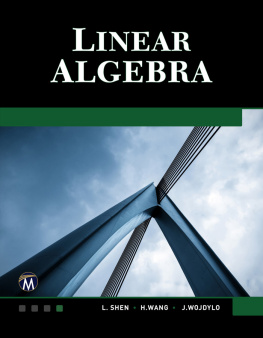
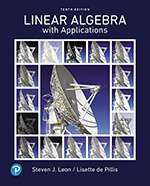

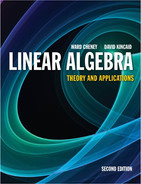

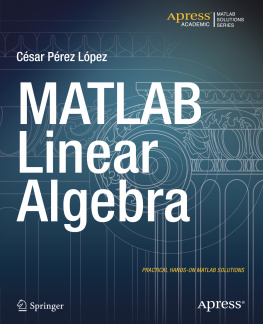
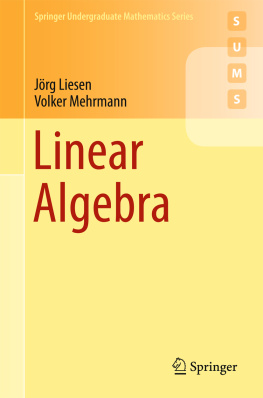
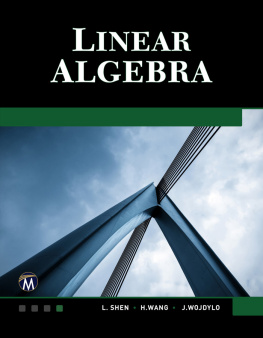
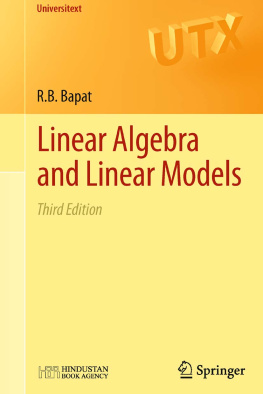



 Dulles, Virginia
Dulles, Virginia